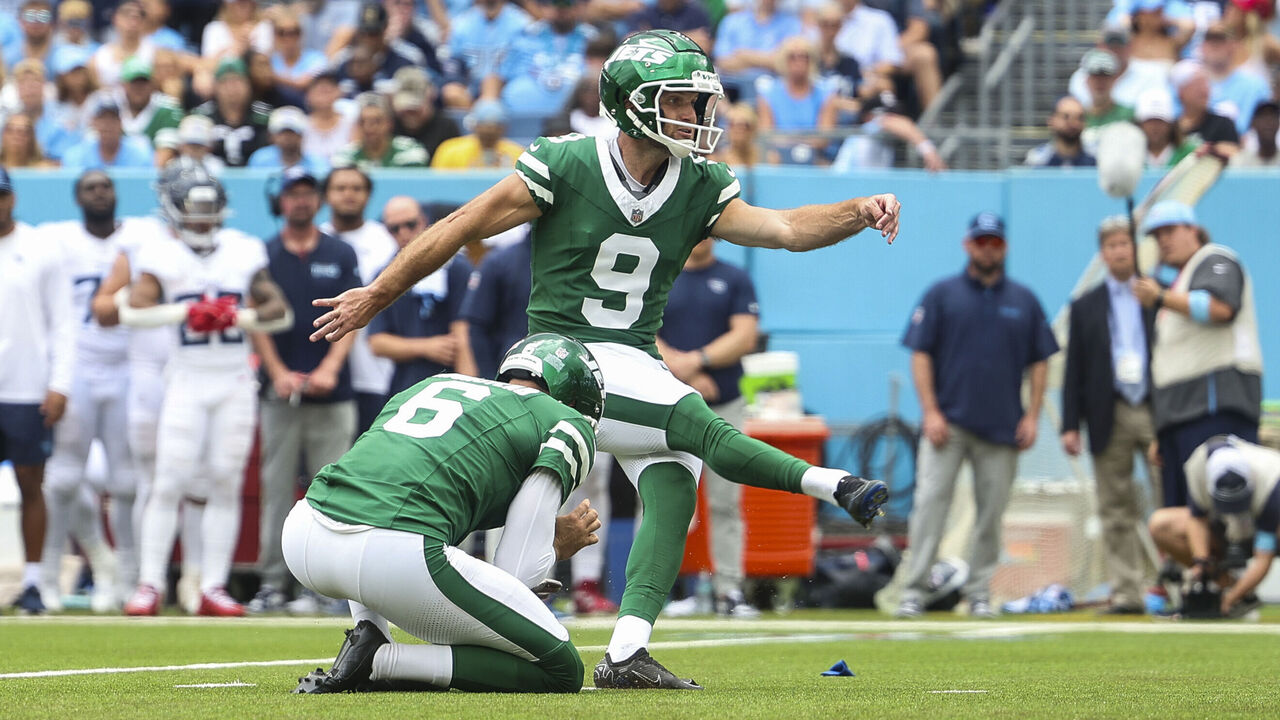NFL kickers have become too good at their craft
One of the great sporting traumas of my formative years was Super Bowl XXV, Buffalo Bills versus New York Giants: Scott Norwood, wide right, tears and heartbreak.
As the Bills were settling for a potential game-winning kick from 47 yards, I clearly remember being very worried that it was too far away. If that kick wasn't quite a prayer, it was definitely an act of hope.
But in today's NFL, 47 yards is close to automatic. On Monday night, after Drake London's last-minute touchdown tied the Falcons-Eagles game, his spectacularly ill-advised shooting celebration resulted in a 15-yard unsportsmanlike penalty that pushed the extra-point try back to 48 yards. Atlanta kicker Younghoe Koo, unfazed, promptly drilled it for the win.
Koo's precision from distance continued a remarkable trend in the young NFL season. The 2024 season's field-goal success rate is 91.7% following Thursday's game; kickers have never finished a season above 87% in league history. Kickers have made 35 of 39 field-goal attempts from 50 yards and beyond through the first two weeks, a rate of 90%. (And that's with Baltimore Ravens stalwart Justin Tucker, the best kicker of all time, 0-for-2 from that range.)
And while kicking accuracy usually gets a good-weather September boost, this year’s numbers are still up significantly from a season as recent as 2020, when kickers through two weeks hit 82.5% of their attempts.
In recent years, long-range kicks are being made at a previously unthinkable rate. NFL kickers hit 69% of their attempts from beyond 50 yards in 2023 - a drop from this small sample size, reflecting a data set that includes the bad weather and poor conditions that teams encounter over a full season.
Which brings us back to poor Scott Norwood. He only made 69% of his field-goal attempts from any distance in that 1990 season and didn't try a single kick beyond 50 yards. He was 6-of-10 from beyond even 40 yards; 47 must have been pretty much the outer limit of his range.
And he wasn't an outlier at the time. League-wide, kickers made just 38% of their attempts beyond 50 yards in 1990. Not surprisingly, there weren't a lot of those long-range attempts - not even five tries per week that season. In two weeks this season, teams have already attempted 39 field goals from beyond 50 yards.
What explains the massive improvement in performance? Basically, the speculative art of kicking became a science. Modern training techniques and an improved understanding of how to efficiently transfer power turned kickers from guys just trying to hoof it in the right direction into athletes who have developed a repeatable set of precise movements.
Kickers are far from the only athletes who have benefited from a better understanding of physics. A baseball pitcher who threw in the mid-90s was considered a major power guy a couple of decades ago; now, one team's staff will have many pitchers throwing in the high 90s. Tiger Woods shocked golf with his fearsome distance in the late 1990s, but now almost every touring pro routinely bombs it more than 300 yards off the tee. (Some of golf's revolution is equipment-related, but modern teaching methods have also harnessed the optimal transfer of energy.)

This power surge is no fluke - kickers who can comfortably thump it from 55 yards and farther out are becoming the norm. What that ultimately means for the sport remains to be seen. Have all the successful long-range kicks created an environment where coaches are more likely to settle for field-goal attempts? Passing touchdowns have dropped sharply this season, but that could be due to a host of reasons - defensive schemes, quarterback play, game scenarios - unrelated to kicking prowess.
This jump in accuracy coincides with a period in which more coaches are using analytics departments, giving them a better understanding of win probability and expected points. They're trying more fourth-down conversions because they often have a greater impact on win probability than attempting a field goal or punt. But the information most of those models are built on also suggested, not that long ago, that a field-goal attempt from beyond 50 yards had worse odds than a coin flip. If long-range kicks are more successful more often, will that diminish the noticeable coaching aggression of recent seasons?
The NFL has encouraged offense in recent decades with rule changes that made the passing game much more effective (and left a legion of retired quarterbacks in broadcast booths grumbling about how much harder things were in their day). It also changed the point-after conversion in 2015 from a 20-yard chip shot to a 33-yard kick because it had become all but automatic. That initially caused the success rate to drop 5 percentage points, but kickers have already erased half of that dip.
If the power surge continues, will field goals be targeted as the new scourge of the league? Will the NFL consider raising the crossbar, or narrowing the uprights?
Or maybe the bad weather is coming - field goals were hit at a 90% rate in the first two weeks of 2023 but finished the season at 86% - and everyone will mostly forget about this trend until next year.
Scott Stinson is a contributing writer for theScore.